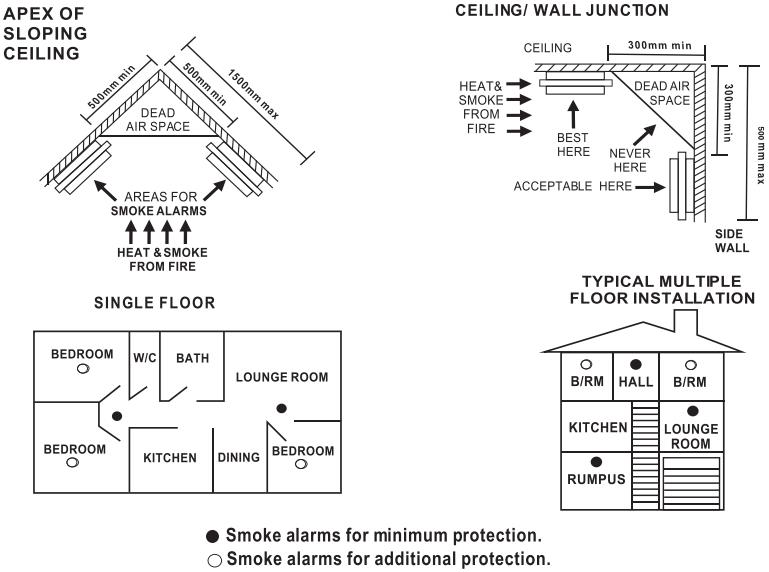This smoke alarm guide helps you understand your interconnected smoke alarm system. You could use the guide to DIY your smoke alarms. Alternatively, to educate yourself before you engage an installation contractor. The guide answers the following:
- How many smoke alarms do I need?
- What type of smoke alarms do I need?
- Where do I locate my smoke alarms in my dwelling?
- Where do I locate my smoke alarms in my rooms?
The online smoke alarm calculator gets you off to a flying start. It also helps you check and record your design.
Smoke alarm calculator
Use the free, online smoke alarm calculator below to determine your needs. Your input at items marked with a * are mandatory for the calculation!
Smoke alarm dwelling locations
Template, smoke alarm floor plans provide examples of installations in a typical dwelling.
New dwellings
Mains powered, wire interconnected smoke alarms are required for all new properties as per the Building Code of Australia.
Existing dwellings
Adding new smoke alarms to an existing dwelling where access to the roof cavity and/or ceiling space to add wiring is not possible, often requires a variety of smoke alarm types. For example, adding interconnected smoke alarms into bedrooms as per the new Queensland Smoke Alarm Legislation. Similarly, adding interconnected smoke alarms to sheds and caravans also poses challenges.
This section is devoted to helping you design your existing dwelling installation.
First of all, do you have mains powered alarms now? To clarify, mains powered alarms incorporate a green LED.
If no, a non-electrician install is simplest for you.
If yes, you could leave your existing mains powered (green LED) alarms in place and still perform a non-electrician install. Alternatively, you may prefer to use mains powered alarms and hence pursue an electrician install.
Non-electrician installs
In short, just install 10Yr lithium battery powered alarms with wireless interconnection. As a result, non-electricians can install these detectors. So for this arrangement, download the sample smoke alarm floor plans below.
Electrician installs
If you are adding mains powered smoke alarms you may need access to the roof space to run additional wiring.
So in the case of a low set property with roof space wiring access, download the sample floor plan below.
But wiring access in the roof space for the new mains powered alarms may not be convenient or even possible. In addition, it is unlikely that you will have wiring access to the ceiling space between floors in a high set dwelling also.
So this is an occasion when you will have a mix of smoke alarm types. In other words, a hybrid system including both mains and battery powered alarms that interconnect both wired and wirelessly. So for this arrangement, download the sample smoke alarm floor plans below.
Smoke alarm room locations
In general, smoke alarms are required along escape routes from each level. In addition, they are either strongly recommended or required in each bedroom. Why? Because, charging phones in bedrooms with the door closed adds fire risk and alarm awareness risk to sleeping occupants.

Smoke alarm floor plans – more details?
Once you have used the smoke alarm calculator and digested the relevant floor plan examples you may want to work out the exact SmokeSight models and quantities for your home. Although most of the time, the information in the sample layouts will allow you to determine your needs. But, if you have a larger installation or you need a hybrid system, you may want to consult the Smoke Alarm Designer.